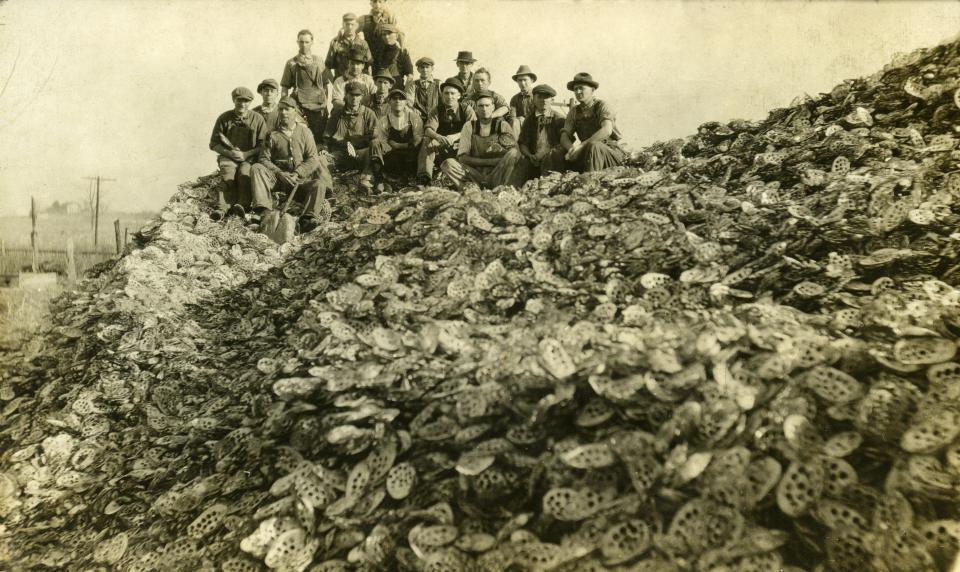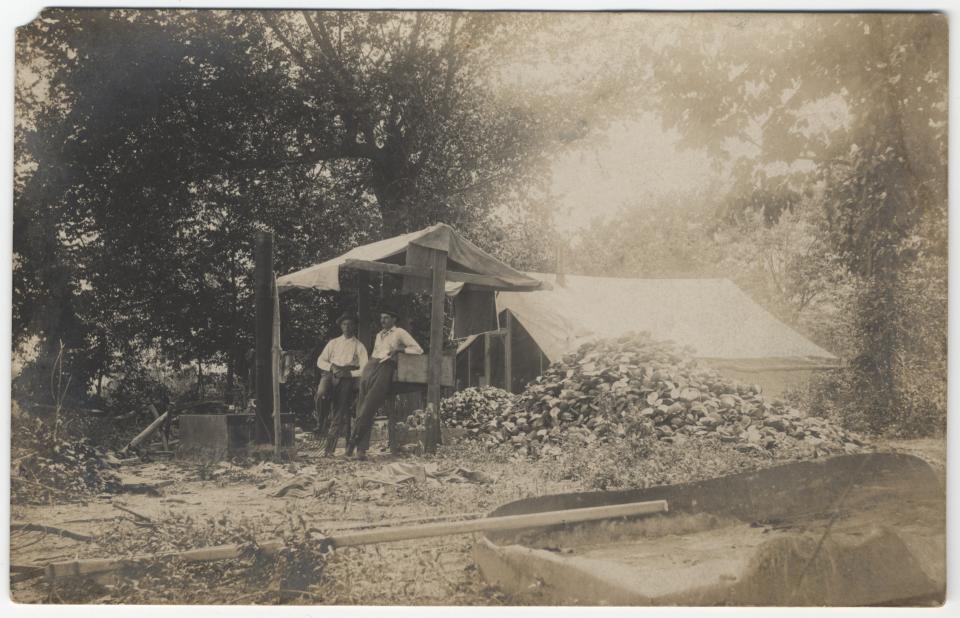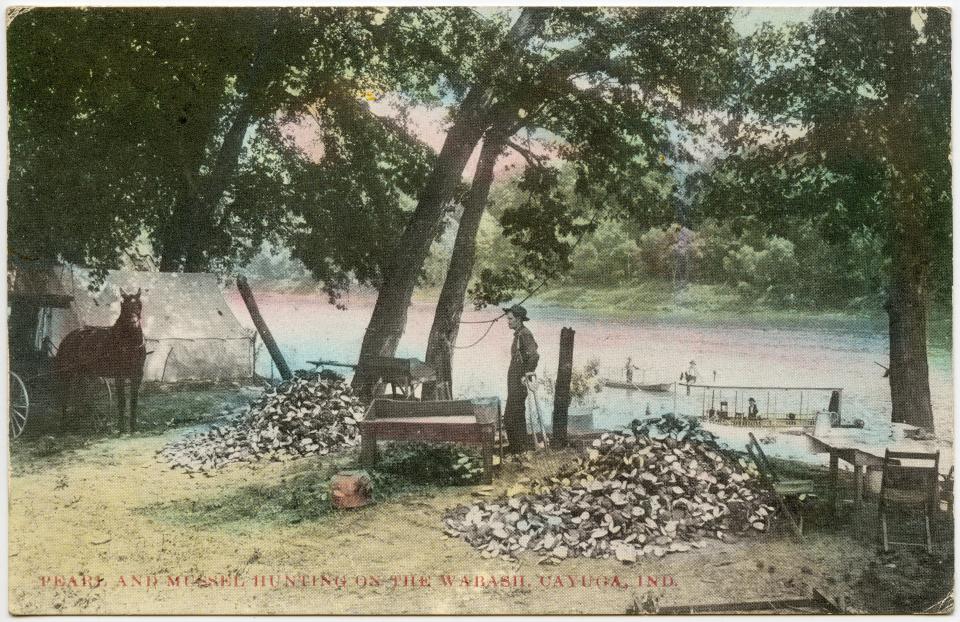'Mussel men' plucked tons of shells from Indiana rivers and streams in the name of fashion
Long before pollution, dams and dredging threatened freshwater mussels living in Indiana rivers and streams, the mollusks faced another devastating menace: Fashion.
A nearly insatiable demand for mother-of-pearl to make buttons in the early 1900s even pushed some species to the brink of extinction. But it didn't stop with translucent buttons.
Salamander mussel: A tiny freshwater mussel found in Indiana could gain federal protection. Here's why
At one time, about 80 different mussel species could be found in waterways across the state, according to the Indiana Department of Natural Resources. But now, IDNR reports "nearly half of Indiana’s native freshwater mussel species" can no longer be found in the state or have been identified as endangered or species of special concern because of sharply declining populations and habitat loss.
That wasn't the case in the 1800s as European colonizers moved in the the Ohio Valley. Dozens of mussel varieties flourished in streams and river beds in what is now Indiana. There, the mussels lived mostly undisturbed by humans until the early 1900s.
That's when a German settler, John Boepple, who lived in Muscatine, Iowa, discovered freshwater mussel shells could be used to make buttons, according to a 1909 article published in Indiana State Normal School’s monthly journal, "The Normal Advance."
Boepple had seen buttons of similar aesthetics back in Germany and began pulling mussels out of the Mississippi River near his home and turning them into buttons. The trend caught on and sales exploded. Business was so good, the demand for more shells to feed the Midwest's booming button industry nearly wiped out mussels in the Mississippi Valley.

The potential for a windfall didn't escape Hoosiers eager to cash in on the plentiful supply of shells free for the taking from waterways across much of the state. As the lucrative craze quickly moved into the Ohio Valley, the 1909 article reported: “There are places on the Wabash River between Terre Haute and Vincennes where it is claimed that more than one hundred mussel boats have been seen at work at one time.”
The mussel men were after the mother-of-pearl layers found inside the shells, and factories sprang up in communities including Mishawaka, Lawrenceburg, Leavenworth, Madison and Shoals to feed the growing demand.
Workers at mussel camps would pull the mollusks from the creeks and rivers by using boats to drag an iron bar, called a crowfoot, outfitted with dozens of lines and hooks. As the hooks were dragged across the river bottom hungry mussels, with their shells open, would latch onto them. The fishermen would then haul their catches to camps, where the mussels were boiled to remove the internal soft tissue and separate the shells.
More wildlife in the water: Indiana biologists find young hellbender in wild for first time since at least the 1980s
Those shells were sent along to factories that used hollow drill bits to cut out discs that were then sanded into button blanks. Depending on their size, as many as 20 button blanks could be drilled from a single shell. Remnant shells still held their original shape, but were full of holes.
Once the blanks were ready, finishers would polish the discs and use a machine to create grooves and drill the holes for thread.

Historic photos from the state library and the Indiana Album show mussel men on boats with their gear and standing among large piles of mussel shells stacked up on banks of creeks and rivers. Even today, remnant shells can still be found in places along the Wabash River and other waterways.
High fashion’s affect on wildlife
Within just a few years, the growing demand for shell buttons started to take a toll on freshwater mussel populations. The decline was serious enough to catch the attention of the U.S. Bureau of Fisheries, which in 1907 began an investigation into the waning populations. The bureau even assigned two biologists to a project aimed at preventing extinction.
Rather than stopping the industry from scooping up all the mussels, the pair took a different approach. They devised a way to propagate mussels and "seed" them into the rivers. This restocking succeeded for a time, helping populations rebound. But according to the Freshwater Mollusk Conservation Society, agricultural practices and sewage from growing cities polluted the waters presented new challenges making it difficult for mussels to thrive.
With Indiana rivers and streams becoming increasingly ill-suited for mussels, the U.S. Army Corps of Engineers delivered yet another blow when it began a mission of building dams. In addition to slowing water flows — mussels prefer and flourish in moving water — the dams further hurt mussel populations by isolating them from the host fish needed for reproduction.

The Bureau of Fisheries ended its propagation program after concluding it wouldn't work, and even advised the mussel men and button makers to finish removing the mollusks before their demise killed the industry. Still, amidst growing concerns about overharvesting mussels, the industry's demand for shells continued. Mussel populations in the Wabash River were repeatedly harvested and by the mid-1950s were again in danger of disappearing, the Terre Haute Tribune-Star reported.
The significant harvest of freshwater mussels in Indiana for buttons finally wound down after the end of World War II, when plastics became widely used to replaced mother-of-pearl from the shells.
When buttons went bust, pearls boomed
The mussel populations didn’t catch a break, however, due to a new industry flourishing in Japan.
Resourceful entrepreneurs had figured out how to grind up and shape bits of freshwater mussel shells harvested in Indiana to feed a demand from Japan. There, the tiny grains of shell were implanted in oysters to create cultured pearls. These pearls form when some irritant, in this case a piece of mussel shell, gets inside the oyster. The mollusk then secretes the same minerals it uses for its shell around the object to protect its soft tissues from being damaged.
The resulting build up, called nacre, eventually forms the pearl.

Mussels from the Wabash River were ideal for the process and in high demand. They had an “extraordinary translucence” that made them especially valuable to the pearl trade, according to an Indiana Academy of Science study published in 1969.
As people again became aware that mussel populations were threatened by a new trend in the fashion industry, IDNR create regulations in 1967 prohibiting the use of mechanical dredges and other commercial methods used to collect mussels. Around this time, mussels also faced other environmental pressures from increasing water pollution and the introduction of invasive Asiatic clams, which present competition for natural food sources.
Industries continued to plunder Indiana’s waterways of mussels until 1991 when the state suspended all forms of harvesting. It is now illegal to take or posses live mussels or, for that matter, keep dead shells from creeks and rivers in Indiana.
Now, more than a century after Indiana's button boom, both the state and the federal wildlife officials are working to restore native freshwater mussel populations in Indiana. One variety in particular, the salamander mussel, is currently proposed for addition to the federal endangered species list.
Karl Schneider is an IndyStar environment reporter. You can reach him at karl.schneider@indystar.com. Follow him on Twitter @karlstartswithk
IndyStar's environmental reporting project is made possible through the generous support of the nonprofit Nina Mason Pulliam Charitable Trust.
This article originally appeared on Indianapolis Star: Where did buttons come from before plastic? One answer: Indiana shells

